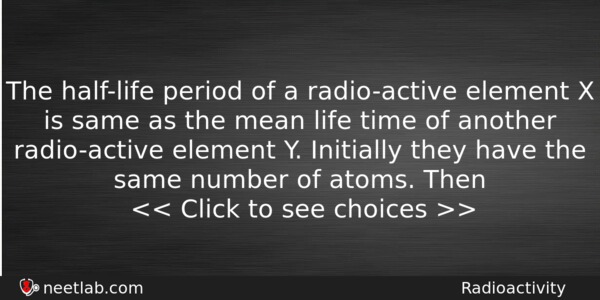| ⇦ | 
| ⇨ |
The half-life period of a radio-active element X is same as the mean life time of another radio-active element Y. Initially they have the same number of atoms. Then
Options
(a) X and Y decay at same rate always
(b) X will decay faster than Y
(c) Y will decay faster than X
(d) X and Y have same decay rate initially
Correct Answer:
X will decay faster than Y
Explanation:
No explanation available. Be the first to write the explanation for this question by commenting below.
Related Questions: - In semiconductor at a room temperature
- The time of reverberation of a room A is one second. What will be the time (in seconds)
- What is the nature of Gaussian surface involved in Gauss’s law of electrostatics?
- A block of 2 kg is kept on the floor. The coefficient of static friction is 0.4
- When a bullet of mass 10 g and speed 100 ms⁻¹ penetrates up to distance 1 cm
Topics: Radioactivity
(83)
Subject: Physics
(2479)
Important MCQs Based on Medical Entrance Examinations To Improve Your NEET Score
- In semiconductor at a room temperature
- The time of reverberation of a room A is one second. What will be the time (in seconds)
- What is the nature of Gaussian surface involved in Gauss’s law of electrostatics?
- A block of 2 kg is kept on the floor. The coefficient of static friction is 0.4
- When a bullet of mass 10 g and speed 100 ms⁻¹ penetrates up to distance 1 cm
Topics: Radioactivity (83)
Subject: Physics (2479)
Important MCQs Based on Medical Entrance Examinations To Improve Your NEET Score
18000+ students are using NEETLab to improve their score. What about you?
Solve Previous Year MCQs, Mock Tests, Topicwise Practice Tests, Identify Weak Topics, Formula Flash cards and much more is available in NEETLab Android App to improve your NEET score.
Share this page with your friends

Leave a Reply